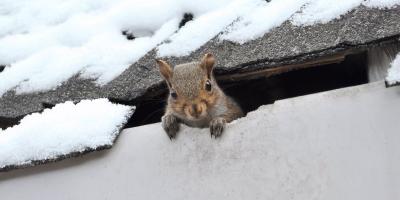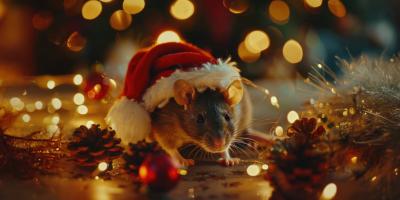Post Halloween Ghouls in Your Home?

With Halloween lurking behind and cold weather rapidly approaching, what kind of pest ghouls might haunt your home through the winter months? New Englanders are in full preparation for the approaching winter season, and so are native and invasive pests.
Let’s begin with a group of pests known as Fall Invaders. Fall Invaders are those insects that frequent structures including commercial and residential buildings, year after year, in search of a warm location to overwinter. Unfortunately, these invaders prefer the same places where people hunker down, so be prepared to share your cozy winter-space with these pesky critters.
Fall Invaders commonly include the following pest species: cluster flies, western conifer seed bugs, brown marmorated stink bugs, boxelder bugs, and Asian ladybug beetles. Cluster flies, western conifer seed bugs, and boxelder bugs are all species that live in North America. The brown marmorated stink bug and the Asian ladybug beetles are invasive species from Asian regions of the world. These two invasive pests were most likely transported to North America via shipping commerce with the raw materials, goods, and on pallets, and in the case of the Asian lady beetles, they were also deliberately introduced by government agencies as a biological control agent against plant attacking pests such as aphids.
Anything to fear from these invading pests?
Not really from a practical standpoint but be prepared in some cases to deal with Hitchcock-movie like bug scenes on warm, sunny winter days. Occasionally, through the winter months, there will be brilliant warm and sunny days. These warm, sunny spells heat south and west facing walls of structures. As they warm, overwintering insects that pack into these southern and western exposure walls (by the thousands) are awakened.
During these days, insects temporarily emerge from hiding as the temperature rises. They venture outside, and unfortunately, inside where they crawl and fly about. Because all these insects are very host specific and highly keyed into natural/outdoor food sources, they are not interested in your food, or any other element of your structure or contents other than warmth and shelter provided in wall voids, attics, and window frames. Moreover, they are not breeding/increasing in numbers either.
Should insecticides be used to reduce or eliminate overwintering insect populations?
The use of insecticides on Fall Invaders once they have fully migrated inside is a big mistake for many reasons. First, insecticides are not necessary to manage the few days of the winter when these pests may temporarily emerge from hiding. If you choose to, simply vacuum them up. As soon as the cold returns, these pests will disappear from sight again. Once spring arrives, these invaders are anxious to return to the outdoors where they can feed and continue their lives. After they exit in spring, they or their progeny will not return until the late summer or early fall when overnight temperatures begin to drop and daylight hours fade into winter. Therefore, effective control and exclusion practices for overwintering pest populations should take place before the insects enter the structure.
Secondly, if insecticides are applied during this hibernation (overwintering) period, thousands of insect carcasses, in hard to access areas, will remain behind. Naturally, some overwintering pests die while in hibernation; however, the application of over-the-counter insecticides and even professional grade materials will fail to reach the depths of their hiding places, the problem will remain, and a new food source for other pests is created. Piles of dead insects will attract other pest species including mice and beetles. The emphasis here is “hard to reach places” and there will be little that can be done to mitigate the issue if the infested areas are inaccessible to physically remove the dead insects.
What to do then if no insecticides?
The best approach to Fall Invaders emerging during the warm, sunny days is to use a vacuum cleaner or shop vac to suck up all the exposed insects. Once the vacuuming is complete, remove the bag or empty the shop vac and place the contents in the trash outside. In many cases, these insects are crushed in the vacuuming process, but with a shop vac, they end up live in the container.
What other pests might attempt to overwinter in homes?
Aside from the Fall Invaders, firewood pests are very commonly introduced into the house during the fall and winter months. Firewood harbors many types of pests including spiders, wood boring beetles, carpenter ants, household ants, ground beetles, and the list goes on. While the firewood is stored outside, the cold temperatures keep these pests in a state of hibernation. When the wood is brought inside and stored near the warm hearth and in a well-heated home, the pests within will awaken from their winter hibernation, surprising the homeowner with sudden pest activity.
Again, insecticides should not be used in this scenario; they are not necessary and are ineffective. Additionally, spraying firewood with an insecticide can be dangerous for a couple of reasons. First reason: most aerosols are highly flammable and the materials within are combustible, so using these products around fire could lead to a fire outside of the fireplace or worse yet, the aerosol can could explode causing injury and fire. Second reason: burning firewood that has been contaminated with an insecticide can be hazardous to people.
What to do then if no pesticide?
Simply burn any logs with visible pests crawling about, assuming the fireplace is lit. If not, remove all wood back to outside cold temperature storage area, and the pests will reenter their hibernation. When it is time to light the next fire, only bring in enough wood for immediate use, and do not store any excess wood inside overnight. Also, engage in a better firewood stock rotation. Firewood that sits outside for multiple seasons before use generally begins to rot and allow insects to harbor during the warm months.
Bottom line: Fall invaders are nuisance pests. They do not eat our food or damage structures, but, like canaries in coal mines, are indicators of “maintenance required” – telling us that gaps around windows, doors, and structure need to be sealed. Ironically, the time to deal with this pest issue is before they show up and make a nuisance of themselves. JP Pest Services offers a thorough and effective Fall Invader Program, and the good news is that we are adding new customers to the 2023 service schedule list now. The timing of these treatments is mission critical for a successful Fall Invader Program, so don’t delay, sign up for next season’s Fall Invader Program now to ensure a spot on the calendar.



